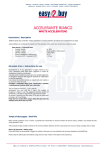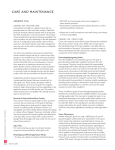Download Daltile G28712121L Use and Care Manual
Transcript
608 N AT U R A L S T O N E C A R E A N D M A I N T E N A N C E G U I D E Dal-Tile does not manufacture installation products or tile cleaning/maintenance products. Dal-Tile provides the information below to its customers as an information source only. Please contact an installation product manufacturer directly, PRIOR to usage, to obtain proper handling instructions, application instruction and warnings concerning potential health hazards for any product contemplated for use. Dal-Tile also strongly recommends testing a small area PRIOR to usage of any installation/tile cleaning/maintenance product to determine whether the product serves its intended purpose. SAFETY PRECAUTION TO CUSTOMERS The products described in this document may have chemicals that cause reactions in certain individuals. Dal-Tile strongly recommends the use of safety glasses, respirators (masks) and gloves in handling any materials that contain chemicals. DalTile recommends the proper disposal of any scrap tile/stone, installation and/or maintenance products discussed herein. Natural stone has its own unique qualities that not only distinguish it from manmade materials, but also should be considered in selecting it for a particular project. Stone is not manufactured; it is a product of nature. Blocks are removed from the quarry, slabs are cut from these blocks, and the slabs are further fabricated into the final stone to be installed. Each block is different; each slab is different. Skillful blending or matching of the dimension stone blocks, veneer panels, tops, etc., results in a beautiful blending of nature’s variety and man’s design. “Uniformity of material,” when applied to natural stone, is a term of relative value that needs to be understood when making a selection. To ensure your natural stone products will provide you with a lifetime of aesthetics and utility, proper maintenance is crucial. Natural stone products are porous by nature and require a different maintenance program than traditional ceramic tile. NEW INSTALLATION Sealing is strongly recommended for newly installed marble and other natural stones to provide maximum stain protection. Be careful to select a high quality sealer to protect your natural stone. • Pre-Grout Sealing A non-sanded grout is strongly recommended for natural stone installations due to the narrow grout joints customarily preferred. This type of grout has very fine particles of cement, polymers, and color pigments that can penetrate the microscopic pores of the stone surface, where they become trapped and may appear as a stain in the stone. Therefore, all travertine, slate, tumbled stone, and honed/flamed/unpolished granite should be sealed prior to the grouting process to protect them from staining. The application of a good quality sealer should be used as a pre-grout sealer and applied again as the final sealing process once the installation is finished. DESIGN WITH CONFIDENCE • Sealing A premium natural look penetrating/impregnating sealer is the normal choice on polished or honed marble, limestone, granite, or where the natural color of a slate is desired. A stone enhancer sealer is often used on tumbled, brushed stones, where a darker, enriched or highlighted character is desired. When choosing either one of these two types of sealers, make sure the brand you have chosen is formulated to provide maximum stain protection for stone products. Stone products should be tested periodically to ensure that the sealer is working effectively. Penetrating/ impregnating stone sealers are a no-sheen, natural look sealer that can be waterbased or solvent-based, good for interior and exterior applications. Most quality sealers of this type are rated to protect the stone for several years. Stone enhancer sealers are also a no-sheen, penetrating/impregnating sealer that is formulated to darken, enrich, and highlight the natural color and beauty of stone products. They will rejuvenate and improve the appearance of worn and weathered stone. However, they will also darken the color of grout joints. They are, generally, suitable for interior and exterior use, and rated to protect the stone for several years. Always reference manufacturers’ literature for specific information on the duration of the sealer’s protection and make sure that the sealer is applied in strict accordance with the manufacturer’s instructions. DALTILE.COM ROUTINE STONE CARE Natural stone requires a different maintenance routine than traditional, man-made ceramic tile. Many of the cleaners acceptable for use on ceramic tile can stain, damage, or dull stone. Dirt and dust will scratch the surface of stone. Therefore, stone floors should be vacuumed or dust mopped frequently to remove abrasive agents from the stone surface. Natural stone should be cleaned with neutral cleaners specifically designed for stone. These cleaners contain no acids and are concentrated neutral pH cleaners that will not affect existing sealers or other types of coatings. Stone cleaners should never contain acid or bleach. Acids, even a light solution of vinegar and water, will etch and eventually damage many varieties of natural stone. A solution of the cleaner and water mixed to manufacturer instructions should be applied to the tile surface with a sponge or mop. On walls, kitchen counters, or vanity tops, a spray bottle can be used to apply the cleaning solution. Allow sitting per manufacturer recommended specified amount of time. Agitate with a sponge, synthetic mop, soft bristle brush, or through the use of a floor-scrubbing machine with soft brushes. Mop up dirty solution and buff dry. Some textured stones may require a different cleaning method or additional procedures not specified in this document. HEAVY-DUTY STONE CLEANING When stone areas have been neglected, you will need to use a heavy-duty stone cleaner and degreaser to effectively remove dirt, grease, grime, waxes, and floor finishes. These cleaning products are concentrated and designed to deep clean the stone without damaging it. Apply the solution of the cleaner and water mix per manufacturer instructions to the stone surface with a sponge or mop. Allow to stand for manufacturerspecified amount of time. Agitate with a sponge, synthetic mop, soft bristle brush, or through the use of a floor-scrubbing machine with soft brushes. Mop up dirty solution and buff dry. Be sure to change out the cleaning solution every 100 square feet to avoid reintroducing dirty water during the cleaning process. Rinse thoroughly with clean water when finished. Make sure to always limit the time water puddles and sits on any type of natural stone and mop dry as soon as possible. STAIN REMOVAL A stone poultice can be used to remove stains and grout haze from stone. Poultice is a fine, non-acidic, absorptive clay cleaning powder that removes stains and light cementitious grout haze from polished and unpolished natural stone. Stone poultice efficacy depends on the nature of the stain and how long the stain has been in the stone. Base the selection of the type of poultice on the nature of the stain. If the stain is too old or has penetrated the stone too deeply, a poultice may not be enough to remove it. Spills should always be cleaned up as soon as possible. CAUTION: Poultice may dull the shine of the polished stone. If this occurs you will need to use a marble polish to restore the natural shine. RESTORATION If your natural stone floor has been damaged or is worn, we recommend that you contact a professional stone restoration company. SOME RECOMMENDATIONS FOR USING NATURAL STONE: Green Marbles & Serpentines: A mechanism exists in many green colored marbles and serpentines that produces a warp in the tile when exposed to water, or a water-based adhesive. Since all standard portland-based thinset compounds are water activated, setting these stones in standard thinset will likely warp the freshly set tiles. The only failsafe method for setting these stones is to use epoxy-based thinset. Research is encouraged on the particular stone species that is being installed, because some green marbles and serpentines exist that do not exhibit this behavior, and therefore can be installed with water-based adhesives. Other green stones exist that only mildly exhibit this behavior, and can be successfully installed using thinset with reduced water volumes, or by wetting the exposed surface of the tiles after installation to provide balanced saturation levels on both surfaces. Fiberglass Mesh Reinforcement: Many stone products exist on the commercial market with a mesh reinforcement adhered to the back surface of the slab or tile. The adhesive used to attach the mesh is not uniform within the industry, but is commonly an epoxy or polyester based adhesive. Portland cement based adhesives will not reliably bond to this surface. The use of epoxy based thinset is required to provide adequate bonding of these tiles. 609 Staining of Light Colored Marbles and Limestones: Light colored marbles and nearly all limestones are subject to staining from grey portland cement components in thinset adhesive. Only white thinsets are to be used when installing these stones. Sanded Grouts: The sand found in sanded grout compounds is generally harder than any of the calcium carbonate based stones (limestones, travertines, marble, onyx). The use of a sanded grout with these materials, particularly if polished, will result in unsightly scratches on the surface finish of the stone tile. Filled Voids in Travertine: Travertine, due to its unique method of formation, will typically include voids within the stone fabric. Most commonly, these holes will be filled at the fabrication site with either cementitious or resinous filler. Particularly in the case of cross cut tiles, many voids can exist just below the finished surface, concealed only by a slight shell of stone material. This concealment prevents detection and filling of this void in the factory. Once in service, a concentrated load on a small area (commonly from a spike heeled shoe, or a heavily loaded service cart with small diameter wheels) will fracture the thin shell of stone, exposing the void below. This is a common and expected occurrence in travertine flooring, and several return visits to the installation will be required to fill these voids as they appear. Pinholes in Marble: On a much smaller scale than the voids found in travertine, many marbles may have pinholes visible in the face of the material. Frequency can be as high as 100 or more per square foot. This is not considered a defect, but rather a natural characteristic of the material. Excessive Depth of Thinset: Many stone varieties, particularly the softer marbles, limestones, and travertines, are extremely vulnerable to non-uniform shrinkage of thinset adhesives. The shrinkage during cure of the thinset can actually warp the tile enough to produce an extremely fine, although visible, crack in the stone. Extreme care should be exercised in substrate prep and installation to provide a uniform depth of thinset adhesive that is within the minimum and maximum depths prescribed by the adhesive manufacturer. Proper Bedding Area: Natural stones are more vulnerable to cracking as a result of voids in the setting bed than most ceramic products. Back-buttering of the stone tile is essential, and the minimum acceptable bedding area is 95% contact with no voids exceeding 2 in2 and no voids within 2" of tile corners on 3/8" tile. The minimum acceptable bedding area is 80% contact with no voids exceeding 4 in2 and no voids within 2" of tile corners on ¾" or thicker material. All corners and edges of stone tiles must always be fully supported and contact shall always be a minimum of 95% in water-susceptible conditions. Grout Dye Staining: The use of dyes in grouts should always be tested to verify that the dyes will not leach into the stone, causing a “picture frame” stain. This is most common when using grouts of contracting color, although grouts dyed with matching color to the stone have been known to cause staining in some instances. Acid Sensitivity: The use of natural stones in environments where acid exposure is likely requires a proper stone selection to avoid attack to the stone. Most notably, the calcium carbonate and calcite based stones will react to relatively mild acids, such as lemon juice, vinegar, and sliced tomatoes. The result is not a stain, which could be removed, but an etching of the stone surface, which cannot be removed without refinishing the stone. In polished finish stones, a mild acid attack will usually manifest itself as a “dull” spot within the surrounding glossy surface. Lot Specific Issues: Being products of nature, stones are subject to the variability of any product harvested from nature. Some stone deposits are remarkably uniform through hundreds of feet of depth times vast lateral distances. There are cases of replacement pieces having been quarried to repair or extend building decades old, and the replacements matched the existing nearly seamlessly. In contradiction to these examples, there are quarries where the inter-block, and even intra-block variability are so great that a given lot of material cannot be matched one month later. In such cases, extreme care is necessary to ensure that adequate quantities are ordered, including requirements for waste, breakage, and attic stock. Requirement for Pre-soaking: Installing high porosity stones in hot, dry climates often requires that the stone be pre-soaked prior to installation. Failure to do so can result in the stone wicking excessive amounts of water out of the setting bed, leaving the bed with inadequate water to accomplish proper hydration of the cements. Translucence: May occur in some white or very lightly colored marbles and onyxes having a crystal structure that will transmit light to varying degrees depending upon stone thickness and finish. Translucence can be an aesthetically intriguing decorative attribute. Mixing Types of Materials: Designs calling for a mixture of stones with different physical properties, while aesthetically interesting, can give rise to problems of wear and of maintenance, mainly on floor areas. Re-polishing will pose problems, should that need arise. The Specifier should be aware that mixing types of stones means there will be different abrasion resistance levels as well as different densities of stones that must be considered in the long term maintenance of the stone and its wearability. Yellowing: A stone may turn yellow due to dirt or soap scum set in it. Waxes and other types of coatings can also yellow with age. Certain stones will naturally yellow with age as a result of oxidation of the iron within the stone. This is especially true with white marbles. Rusting: Some stones, and specifically slates, contain deposits of minerals that can react to moisture. Stone bleeding or rusting is a common example of this. Caution should be used in installations where slate would be exposed to standing, run off water or too much humidity. As water works its way through the stone, if the stone contains iron oxide, some of it may liquefy. This iron will eventually surface through the stone and deposit itself on the surface of the stone. The rust will return over time and may have to be cleaned periodically. MOST COMMON STONE FINISHES: Polished: Mirror gloss, with sharp reflections. Honed: Dull sheen, without reflections, achieved by abrasive heads. The degree of honing depends on the stone, but may vary from light to heavy. Generally, it is recommended that a natural stone floor receive a honed rather than a highly polished finish in commercial applications. Etching, scratching, and traffic paths will be far less obvious on a honed surface, thus making for easier maintenance. Flamed or Thermal: Plane surface with flame finish applied at high temperature by mechanically controlled means to ensure uniformity; changes the color of the stone. Water-jet Finish: Gives a more uniform, textured finish and allows more of the natural color to show. Sandblasted: Coarse plane surface produced by blasting an abrasive, allowing a finetextured finish; may lighten the color. Bush-hammered: Coarsely textured surface produced by hammering, and may vary according to the metallic head used, from fine point to very coarse, and may leave high, lighter-colored markings. Natural Cleft: A cleavage face formed when the stone is split into any thickness. Tumbled: Method of putting tiles in a mixing container with sand and rotating them, allowing the edges and corners of the tiles to chip. This method is used to give an antique and old look. Brushed: This finish is created by using specific brushes to give the stone a softer, aged look. When stones are brushed, micro-veins open up. With traffic, brushed stones will increase their patina naturally and more veins may open up. Gauged: Done by a machine, usually with circular abrasives to grind the material to a specific thickness. DALTILE.COM DESIGN WITH CONFIDENCE Delamination: Many stone varieties have pronounced bedding planes, along which a predetermined “rift” exists. “Rift” is defined simply as the direction along which a stone is most easily split. Bedding planes can be a region of weakness, and some stones, particularly sandstones and some slates, will actually delaminate along interbedding plane boundaries after installation. This will result in a portion of the stone thickness separating and dislodging itself from the rest of the stone, and is not related to any failure in adhesive, since the bonded portion of the stone remains in place. Research is required to verify the adequacy of the stone material for the intended application. Differential mineral expansion due to weathering and thermal cycles tend to accelerate this occurrence, and freeze/thaw cycling is obviously an additional factor. Lippage vs Grinding in Place: Lippage in stone tile flooring is accentuated from what would be perceived in a ceramic tile flooring for several reasons. Natural stones tend to be installed with tighter joints, they typically have extremely slight, or no chamfer at their edges, and many natural stones are provided in a very high gloss, polished surface finish. Industry standards limit lippage between adjacent units of smooth finished natural stone flooring to 1/32", which is approximately the thickness of a standard, plastic credit card. When this is not achieved, there is the option of grinding the stone tiles in place to eliminate the lippage. This work is to be done by skilled, experienced technicians, as care must be taken to avoid a “wavy” looking finished floor. In some cases, installing contractors will plan to grind the finished floor regardless of the lippage amount, usually per the requirement of the client. Lippage should still be minimized to the extent possible during installation to avoid extremely thin stone sections after grinding.

















